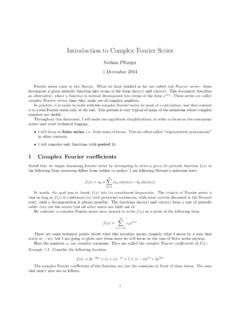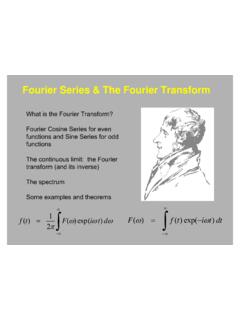Transcription of 16 Convergence of Fourier Series
1 16 Convergence of Fourier Series Pointwise Convergence of Fourier Series Definition: Piecewise smooth functions For f defined on interval [a, b], f is piecewise smooth on [a, b] if there is a partition of [a, b], {xj }pj=0 , a = x0 < x1 < .. < xp = b, such that f is continuously differentiable on each subinterval (xj , xj+1 ), and at each xj , f or its derivative f 0 has at most a jump discontinuity. Example: Let . 2x 0 x 1/2. f (x) =. 1/2 1/2 < x 1 . This f is piecewise smooth on [0, 1], but is not continuous on [0, 1]. However, f (x) = |x|1/2 is continuous on [ 1, 1], but is not piecewise smooth on [ 1, 1].
2 Why? Now we give some Convergence results, scaling l to unity. Theorem 1: Convergence of Fourier sine and cosine Series If f is piecewise smooth on closed interval [0, 1], and continuous on (0, 1), then the Fourier sine and cosine Series converge for all x in [0, 1], and has sum f (x) in (0, 1). Remark: If f is continuous on [0, 1], then these two Series also converge to f (x) at x = 0, 1. (Note that for example 11 , where f (x) R, this is not met.). Theorem 2: Convergence of the full Fourier Series If f is piecewise smooth on [ 1, 1], continuous on ( 1, 1), then the Fourier Series converges for all x [ 1, 1], and has sum f (x+) + f (x ).
3 Where f (x ) = lim 0 f (x ) . 2. 1. All references to numbered examples in this section refer to examples presented in the last section. 1. Figure 1: From the sine Series example 2, graph on the left side, a, shows the function extended to the symmetric interval as an odd function. The graph on the right side, b, shows the extended function as a 2-periodic function on the real line. In the pde problems that we have solved that employed P either Dirichlet or Neumann , P we either arrived at writing f (x) = n 1 bn sin(n x), or f (x) = a20 + n 1 an cos(n x) (assuming without loss of generality the interval has been scaled to (0, P1)).
4 We made no claim to Convergence , so we should have written f (x) n 1 bn sin(n x), etc. Keep in mind that what Series we end up with is entirely determined by what are imposed. We will generally state pde problems where initial/ boundary data are continuous on the open interval making up the spatial domain, and dispense with the tilde' notation. The issue here is that the Convergence we have been discussing is point- wise Convergence . Another comment is that when we obtain the Fourier Series for the data, for example, in examples 1-4, the trig Series on the right side actually are defined for all x R, while the function on the left side, f , comes from the original statement of the problem and is only defined on (0, 1) (or (0, l) or ( l, l)).
5 So what function does the Series converge to on the real line? For a function f defined on the (0, l), we must first extend it to ( l, l), then extend it to the whole real line as a 2l-periodic function. If the Series is a sine Series , this represents a Series of odd functions, so f must be extended to ( l, l) as an odd function (mirror the graph of f about the y-axis, then flip' if down, mirror it about the negative x-axis). Example: f (x) . P. n=1 bn sin(n x), where f (x) = x on (0, 1). Then extend it to ( 1, 1) as an odd function (see figure 3, left side graph).
6 Then extend it to the real line as a 2-periodic function. Now, from the the- orem on the Convergence of the full Series , the Series converges to f (x) for 2. Figure 2: From the cosine Series example, graph on the left side, a, shows the function extended to the symmetric interval as an even function. The graph on the right side, b, shows the extended function as a 2-periodic function on the real line. x ( 1, 1) (and actually for x (2n 1, 2n + 1), for all integers n), but converges to 0, the average jump at each discontinuity at every other integer (see figure 1, right side graph).
7 A0. P . Example: f (x) 2. + n=1 an cos(n x), where f (x) = x on (0, 1). The sum is a sum of even functions, so f is extended to ( 1, 1) as an even function (mirror the graph of f about the y-axis). Then extend the func- tion to the real line as a 2-periodic function (see figure 2). Note now that the extended function is continuous for all x R and so the Fourier Series converges everywhere to the extended function on the line (figure 2). Put another way, we have continuity of f at the endpoints x = 1, so the Fourier Series converges everywhere to f (x).
8 Observe that this extended function, call it f (x), is piecewise smooth on R because it has its derivative having simple jump discontinuities at the odd integers; otherwise it is continuously differentiable. Example 4 revisited: We have f (x) = x(1 x), and the case of a sine Series , so extend f as an odd function on ( 1, 1) (see figure 5, left side graph). So, extended to the whole real line we have what is pictured in figure 5, right side graph. In this case the extended function and its derivative are continuous everywhere on R.
9 How is this reflected in the Fourier Series ? From example 2, with the extended function being piecewise continuous (see page 5 of the last section) the Fourier coefficients decay like 1/n as n . From example 3, the extended function is continuous (and its derivative is piecewise continuous) on R, and its coefficients decay like 1/n2 as n . However, 3. Figure 3: Graphs showing the extension of the function f (x) = x(1 x) for example 4, showing first extending to ( 1, 1) as an odd function, then to the whole real line. from example 4, page 7 of the last section, the extended function and its derivative are both continuous on R, and its Fourier coefficients decay like 1/n3 as n.
10 Through the Riemann-Lebesque lemma and other analytic results one can characterize the decay rate of Fourier coefficients (and hence the rate of Convergence of the infinite Series ) through piecewise smoothness conditions on f (x), but we will not pursue the matter further in these Notes. Nothing we have said so far addresses what to expect when we have jump discontinuities, how good of an approximation we can make, and how we can verify that the Series we compute actually can be checked to see that it is a solution to our problem.




